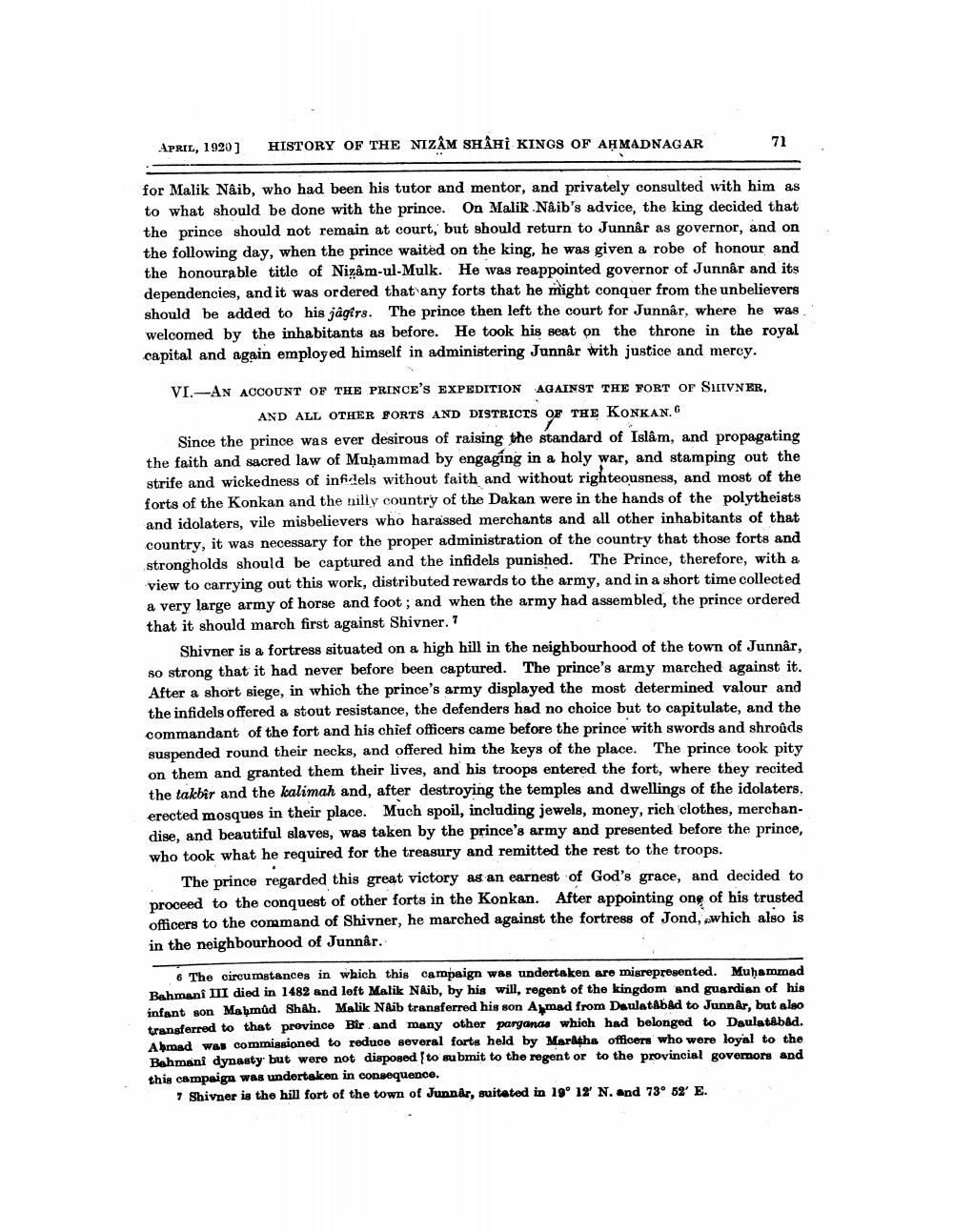________________
April, 1920]
HISTORY OF THE NIZAM SHAHÌ KINGS OF AĦMADNAGAR
71
for Malik Näib, who had been his tutor and mentor, and privately consulted with him as to what should be done with the prince. On Malik Naib's advice, the king decided that the prince should not remain at court, but should return to Junnar as governor, and on the following day, when the prince waited on the king, he was given a robe of honour and the honourable title of Nizâm-ul-Mulk. He was reappointed governor of Junnår and its dependencies, and it was ordered that any forts that he might conquer from the unbelievers should be added to his jagirs. The prince then left the court for Junnâr, where he was welcomed by the inhabitants as before. He took his seat on the throne in the royal capital and again employed himself in administering Junnar with justice and mercy.
VI.-AN ACCOUNT OF THE PRINCE'S EXPEDITION AGAINST THE FORT or SUVNER,
AND ALL OTHER FORTS AND DISTRICTS OF THE KONKAN. Since the prince was ever desirous of raising the standard of Islâm, and propagating the faith and sacred law of Muhammad by engaging in a holy war, and stamping out the strife and wickedness of infidels without faith and without righteousness, and most of the forts of the Konkan and the nilly country of the Dakan were in the hands of the polytheists and idolaters, vile misbelievers who harassed merchants and all other inhabitants of that country, it was necessary for the proper administration of the country that those forts and strongholds should be captured and the infidels punished. The Prince, therefore, with a view to carrying out this work, distributed rewards to the army, and in a short time collected a very large army of horse and foot; and when the army had assembled, the prince ordered that it should march first against Shivner.?
Shivner is a fortress situated on a high hill in the neighbourhood of the town of Junnar, so strong that it had never before been captured. The prince's army marched against it. After a short siege, in which the prince's army displayed the most determined valour and the infidels offered a stout resistance, the defenders had no choice but to capitulate, and the commandant of the fort and his chief officers came before the prince with swords and shroûds suspended round their necks, and offered him the keys of the place. The prince took pity on them and granted them their lives, and his troops entered the fort, where they recited the takbîr and the kalimah and, after destroying the temples and dwellings of the idolaters. erected mosques in their place. Much spoil, including jewels, money, rich clothes, merchandise, and beautiful slaves, was taken by the prince's army and presented before the prince, who took what he required for the treasury and remitted the rest to the troops.
The prince regarded this great victory as an earnest of God's grace, and decided to proceed to the conquest of other forts in the Konkan. After appointing ong of his trusted officers to the command of Shivner, he marched against the fortress of Jond, which also is in the neighbourhood of Junnar.
The circumstances in which this campaign was undertaken are misrepresented. Muhammad Bahmani III died in 1482 and loft Malik Naib, by his will, regent of the kingdom and guardian of his infant son Mahmud ShAh. Malik Naib transferred his son Aymad from DaulatAbAd to Junnar, but also transferred to that province Bir and many other parganas which had belonged to Daulatábad. Ahmad was commissioned to reduce several forts held by Marktha officers who were loyal to the Bahmani dynasty but were not disposed to submit to the regent or to the provincial governors and this campaign was undertaken in consequence.
7 Shivner is the hill fort of the town of Junnar, suitated in 19° 12' N. and 73° 52' E..




